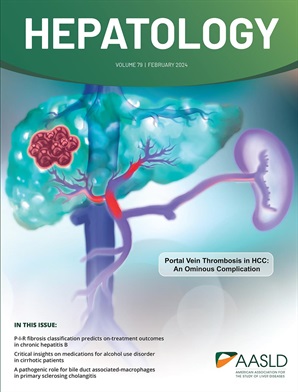Chiglitazar in MASLD with hypertriglyceridemia and insulin resistance: A phase II, randomized, double-blind, placebo-controlled study
IF 15.8
1区 医学
Q1 GASTROENTEROLOGY & HEPATOLOGY
引用次数: 0
Abstract
Background and Aims: Metabolic dysfunction-associated steatotic liver disease (MASLD) can progress to severe forms such as metabolic dysfunction-associated steatohepatitis (MASH). Effective treatments for MASH are urgently needed. This study aimed to evaluate the efficacy and safety of chiglitazar, a PPAR pan-agonist, in MASLD with hypertriglyceridemia and insulin resistance. Approach and Results: In this phase II multicenter, randomized, double-blind and placebo-controlled study, 104 patients with MASLD with hypertriglyceridemia and insulin resistance were randomized 2:2:1 to receive 48 mg, 64 mg of chiglitazar, or placebo once daily for 18 weeks. The primary endpoint was the percentage change in liver fat content measured by magnetic resonance imaging proton density fat fraction (MRI-PDFF) at week 18. Chiglitazar significantly reduced liver fat content, with percentage change from baseline at week 18 of -28.1% (95% CI -37.5 to -18.7) in the 48 mg group and -39.5% (95% CI -49.0 to -30.0) in the 64 mg group, compared to -3.2% (95% CI -16.8 to 10.4) in placebo group. The differences compared to placebo were -24.9% (齐格列他治疗伴有高甘油三酯血症和胰岛素抵抗的MASLD:一项随机、双盲、安慰剂对照的II期研究
背景和目的:代谢功能障碍相关脂肪性肝病(MASLD)可发展为严重的形式,如代谢功能障碍相关脂肪性肝炎(MASH)。迫切需要有效的治疗MASH。本研究旨在评估chiglitazar(一种PPAR泛激动剂)治疗伴有高甘油三酯血症和胰岛素抵抗的MASLD的有效性和安全性。方法和结果:在这项II期多中心、随机、双盲和安慰剂对照研究中,104例伴有高甘油三酯血症和胰岛素抵抗的MASLD患者以2:2:1的比例随机接受48 mg、64 mg或安慰剂治疗,每天一次,持续18周。主要终点是第18周通过磁共振成像质子密度脂肪分数(MRI-PDFF)测量的肝脏脂肪含量的百分比变化。Chiglitazar显著降低肝脏脂肪含量,与基线相比,第18周时48 mg组的百分比变化为-28.1% (95% CI为-37.5至-18.7),64 mg组的百分比变化为-39.5% (95% CI为-49.0至-30.0),而安慰剂组的百分比变化为-3.2% (95% CI为-16.8至10.4)。与安慰剂相比,48毫克组的差异为-24.9% (p < 0.05), 64毫克组的差异为-36.3% (p < 0.001)。Chiglitazar还能显著改善肝损伤相关的生物标志物,如ALT、AST和γ-GT。肝纤维化指标、脂质参数、胰岛素抵抗、代谢综合征均有改善趋势。两种剂量的chiglitazar耐受性良好,大多数不良事件为轻度至中度。结论:Chiglitazar可显著降低MASLD伴高甘油三酯血症和胰岛素抵抗患者肝脏脂肪含量,具有剂量依赖性和良好的安全性。
本文章由计算机程序翻译,如有差异,请以英文原文为准。
求助全文
约1分钟内获得全文
求助全文
来源期刊

Hepatology
医学-胃肠肝病学
CiteScore
27.50
自引率
3.70%
发文量
609
审稿时长
1 months
期刊介绍:
HEPATOLOGY is recognized as the leading publication in the field of liver disease. It features original, peer-reviewed articles covering various aspects of liver structure, function, and disease. The journal's distinguished Editorial Board carefully selects the best articles each month, focusing on topics including immunology, chronic hepatitis, viral hepatitis, cirrhosis, genetic and metabolic liver diseases, liver cancer, and drug metabolism.
 求助内容:
求助内容: 应助结果提醒方式:
应助结果提醒方式:


